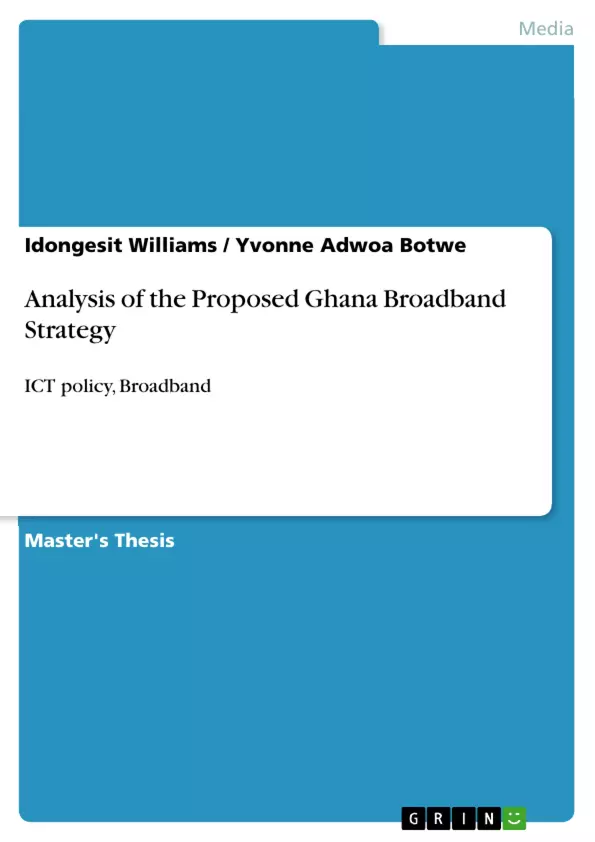This project studied the Ghana Broadband Strategy with the aim of evaluating the recommendations in the strategy side by side the broadband development in Ghana. The researchers conducted interviews both officially and unofficially with ICT stakeholders, made observations, studied Government publications and sourced information from the internet in order to find out the extent of broadband development in Ghana. A SWOT analysis is carried out to determine the strengths, weaknesses, opportunities and threat to the development of broadband market in Ghana. The facilitation, regulatory and market intervention policies recommended in the Ghana broadband policy is used to evaluate the broadband market to find out whether the strategy consolidates with the Strengths and opportunities of the market and whether it corrects the anomalies that necessitate the weaknesses and threats to the market. A comparative analysis is carried out with broadband strategies in other nations to consolidate the perceived omissions in the Ghana broadband Strategy.
In our findings, the researchers saw the Ghana broadband Strategy to be a positive start towards developing a comprehensive broadband strategy for Ghana. The strategy did address some threats and weaknesses of the broadband market. It also consolidated on some strengths and opportunities of the broadband market. The researchers also discovered that a market can actually grow without a policy. But a market will grow faster if a well implemented policy is guiding the market.
It is the hope of the researchers that this academic exercise will be useful to anyone who wishes to study the policy effect on the Ghanaian telecommunications market and the Ghanaian approach to Universal Access and Service.
Inhaltsverzeichnis (Table of Contents)
- Abstract
- Chapter 1: Introduction
- Chapter 2: Literature Review
- Chapter 3: Research Methodology
- Chapter 4: Findings and Analysis
- Chapter 5: Conclusion (Not included in preview)
Zielsetzung und Themenschwerpunkte (Objectives and Key Themes)
This project aims to evaluate the Ghana Broadband Strategy by comparing its recommendations with the actual broadband development in Ghana. The research involved interviews with ICT stakeholders, observations, analysis of government publications, and internet research to assess the extent of broadband development.
- Assessment of the Ghana Broadband Strategy's effectiveness.
- Analysis of the strengths, weaknesses, opportunities, and threats (SWOT) in Ghana's broadband market.
- Evaluation of the strategy's alignment with market realities.
- Comparative analysis with broadband strategies in other countries.
- Examination of the relationship between policy and market growth.
Zusammenfassung der Kapitel (Chapter Summaries)
Chapter 1: Introduction: This chapter provides background information on the Ghana Broadband Strategy and the objectives of the research.
Chapter 2: Literature Review: This chapter reviews existing literature on broadband development strategies, particularly focusing on relevant international examples and best practices. (Details omitted to avoid spoilers.)
Chapter 3: Research Methodology: This chapter outlines the research methods employed, including interviews, observations, and document analysis, detailing the data collection process and selection of relevant sources. (Specific details omitted to avoid revealing research biases.)
Chapter 4: Findings and Analysis: This chapter presents the key findings from the research. It includes a SWOT analysis of the broadband market in Ghana and a comparative analysis with other countries' broadband strategies. (Specific findings are omitted to avoid spoilers.)
Schlüsselwörter (Keywords)
Ghana Broadband Strategy, broadband development, ICT stakeholders, SWOT analysis, policy evaluation, comparative analysis, market growth, universal access, telecommunications market.
- Citation du texte
- Idongesit Williams (Auteur), Yvonne Adwoa Botwe (Auteur), 2010, Analysis of the Proposed Ghana Broadband Strategy, Munich, GRIN Verlag, https://www.grin.com/document/183243



